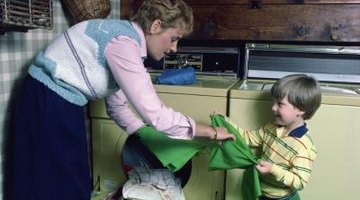What Gauge Wire Is Used to Wire a Dryer Outlet?
To dry clothing properly, a large amount of heat must be added to the chamber of a clothes dryer. To produce enough heat, the heating elements of an electric dryer must use thousands of watts of electrical power. Due to its power requirements, an electric dryer must be connected to the electrical service by wire that is thicker in diameter -- or larger in gauge -- than most electrical circuits in a typical household.
Wire Gauge and Ampacity

Ampacity is the ability of an electrical wire to carry electric current. An electrical wire that has a small diameter is capable of carrying less electric current than a wire with a large diameter. In North America, wire diameter is commonly expressed in American Wire Gauge, or AWG. A 14 AWG insulated copper wire -- which has a diameter of 1.29 millimeters -- is often used to wire household circuits that will draw 15 amps of current or less. For circuits that will draw up to 20 amps of current, the wire that is most commonly used is 12 AWG insulated copper wire, which is 2.05 millimeters in diameter.
Voltage Considerations
Many electric circuits in a home use one of the two output phases on the home’s transformer. Each output phase provides 120 volts of AC electrical power. However, electric dryers require 240 volts to operate; this requires the dryer to receive power from both phases to receive the full 240 volts. Dryer electrical sockets provide two “hot” connections -- one connected to each phase on the transformer -- to provide the necessary voltage to the dryer.
Dryer Outlets Require Thick Wire
An electric dryer may require as much as 5,000 watts of power. At 240 volts, this appliance would require wiring that is capable of handling more than 20 amps of power continuously. To provide that much electric current without overheating any of the conductor wires, the wires in a dryer electric outlet must be at least 10 AWG, or 2.59 millimeters in thickness. Dryer electrical circuits are often wired with 10 AWG three-conductor (also known as “10/3”) insulated copper wire.
Other Considerations
For new electrical circuits, a dryer outlet must have four wires connected to the outlet. These wires are color coded as to function. The red wire is the hot wire coming from the first transformer phase. The black wire is the hot wire coming from the second transformer phase. The white wire is the neutral (or “return”) wire. The bare copper or green wire is the ground wire.
Despite its name, a 10/3 electrical wire contains all four colored wires in the cable assembly.
References
Writer Bio
David Sandoval has served as a trainer and technical writer since 2000. He has written several articles online in the fields of home improvement, finance, electronics and science. Sandoval has an Associate of Applied Science in microelectronics from Northern New Mexico College.
Photo Credits
- Jupiterimages/Photos.com/Getty Images
More Articles


